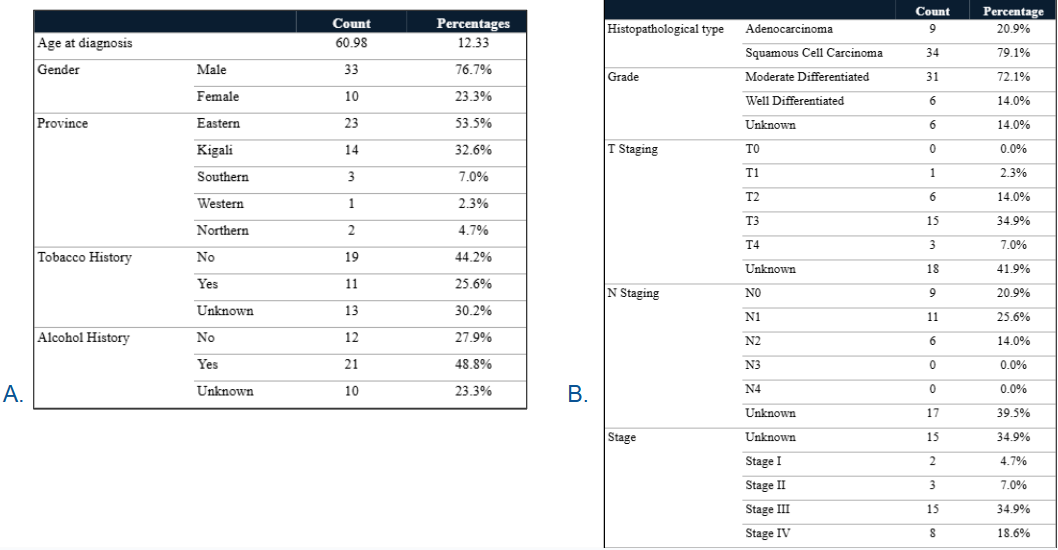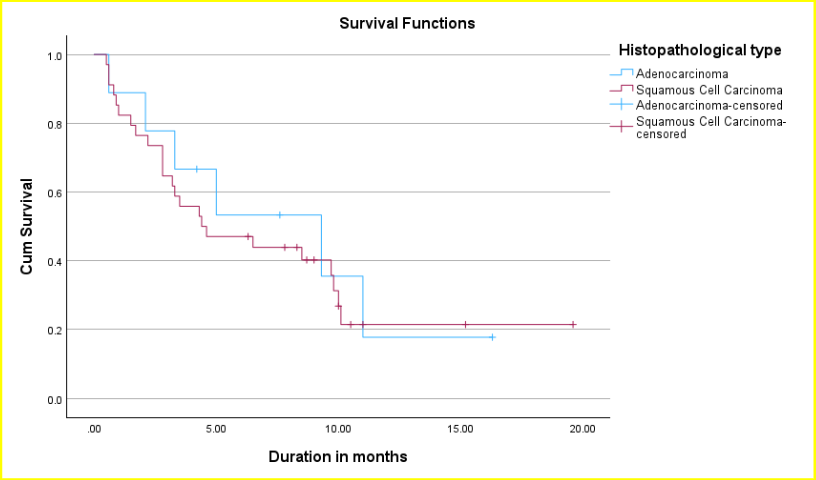Monday Poster Session
Category: Esophagus
P2751 - Assessment of Esophageal Cancer Risk Factors and Management Outcomes Among Esophageal Cancer Patients Attending Rwanda Healthcare Facilities in 2023
Monday, October 27, 2025
10:30 AM - 4:00 PM PDT
Location: Exhibit Hall
- TM
Tarig Mohamed, MBBS (he/him/his)
Ministry of National Guard Health Affairs (MNGHA)
Al Mubarraz, Ash Sharqiyah, Saudi Arabia
Presenting Author(s)
Tarig Mohamed, MBBS1, Bukuru John, MBBS2, Rana Mohamed, MBBS1
1Ministry of National Guard Health Affairs (MNGHA), Al Mubarraz, Ash Sharqiyah, Saudi Arabia; 2Rwanda Military Hospital, Kigali, Kigali, Rwanda
Introduction: Esophageal cancer is the 11th most frequently diagnosed cancer in the world and the 7th most widespread cause of cancer-related deaths. Comprehensive studies addressing risk factors and management outcomes for esophageal cancer are notably lacking in the Rwandan context. The Specific objectives here are to identify and determine the frequencies of different risk factors, tumor characteristics, management modalities and to compare the 6-month survival rates between the different cancer subtypes.
Methods: This was an observational, retrospective descriptive study which performed total coverage of all esophageal cancer patients that attended a cancer center and a tertiary teaching hospital in 2023, and then used statistical analyses using SPSS version 26.
Results: This study was comprised of 43 esophageal cancer patients with an average age of 60.98 years. Nearly all were male ( 76.7 %), with most participants from the eastern province ( 53.5 %). Tobacco and alcohol use were reported in 25.6 % and 48.8 % of cases, respectively. The predominant histopathological type was squamous cell carcinoma ( 79.1 %), with 20.9 % having adenocarcinoma. Most tumors were moderately differentiated ( 72.1 %), and 34.9 % of patients were at stage III, with 18.6 % at stage IV. Chemotherapy combined with radiotherapy was the most common treatment ( 23.3 %). The overall 6-month survival rate was 60.4 %, with esophageal adenocarcinoma patients showing a 66.6 % survival rate and esophageal squamous cell carcinoma patients a 58.8 % rate. Median survival was 9.3 months for adenocarcinoma and 4.4 months for squamous cell carcinoma. Hazard ratio analysis indicated worse outcomes for patients with a history of tobacco use (HR= 1.549, 95 % CI: 1.228 - 18.026, p= 0.024 ) but other factors did not show significant associations with survival.
Discussion: The Eastern province of Rwanda continues to produce the most esophageal cancer patients, based on this research and previous studies. Furthermore, the histopathological subtype showed typical developing country distribution, with four-fifths of all cancers being squamous cell carcinoma. Despite its proven favorable outcomes on survival, not a single patient underwent surgery. Moreover, the 6-month survival rate improved when compared to previous research here in Rwanda. Finally, further research is needed for esophageal cancer here in Rwanda and a screening program should be considered for those at high risk.

Figure: A. Demographics and Risk Factors among participants.
B. Tumor characteristics.

Figure: Kaplan-Meier survival curves for patients diagnosed with Adenocarcinoma and Squamous Cell Carcinoma (cause-specific survival).
Disclosures:
Tarig Mohamed indicated no relevant financial relationships.
Bukuru John indicated no relevant financial relationships.
Rana Mohamed indicated no relevant financial relationships.
Tarig Mohamed, MBBS1, Bukuru John, MBBS2, Rana Mohamed, MBBS1. P2751 - Assessment of Esophageal Cancer Risk Factors and Management Outcomes Among Esophageal Cancer Patients Attending Rwanda Healthcare Facilities in 2023, ACG 2025 Annual Scientific Meeting Abstracts. Phoenix, AZ: American College of Gastroenterology.
1Ministry of National Guard Health Affairs (MNGHA), Al Mubarraz, Ash Sharqiyah, Saudi Arabia; 2Rwanda Military Hospital, Kigali, Kigali, Rwanda
Introduction: Esophageal cancer is the 11th most frequently diagnosed cancer in the world and the 7th most widespread cause of cancer-related deaths. Comprehensive studies addressing risk factors and management outcomes for esophageal cancer are notably lacking in the Rwandan context. The Specific objectives here are to identify and determine the frequencies of different risk factors, tumor characteristics, management modalities and to compare the 6-month survival rates between the different cancer subtypes.
Methods: This was an observational, retrospective descriptive study which performed total coverage of all esophageal cancer patients that attended a cancer center and a tertiary teaching hospital in 2023, and then used statistical analyses using SPSS version 26.
Results: This study was comprised of 43 esophageal cancer patients with an average age of 60.98 years. Nearly all were male ( 76.7 %), with most participants from the eastern province ( 53.5 %). Tobacco and alcohol use were reported in 25.6 % and 48.8 % of cases, respectively. The predominant histopathological type was squamous cell carcinoma ( 79.1 %), with 20.9 % having adenocarcinoma. Most tumors were moderately differentiated ( 72.1 %), and 34.9 % of patients were at stage III, with 18.6 % at stage IV. Chemotherapy combined with radiotherapy was the most common treatment ( 23.3 %). The overall 6-month survival rate was 60.4 %, with esophageal adenocarcinoma patients showing a 66.6 % survival rate and esophageal squamous cell carcinoma patients a 58.8 % rate. Median survival was 9.3 months for adenocarcinoma and 4.4 months for squamous cell carcinoma. Hazard ratio analysis indicated worse outcomes for patients with a history of tobacco use (HR= 1.549, 95 % CI: 1.228 - 18.026, p= 0.024 ) but other factors did not show significant associations with survival.
Discussion: The Eastern province of Rwanda continues to produce the most esophageal cancer patients, based on this research and previous studies. Furthermore, the histopathological subtype showed typical developing country distribution, with four-fifths of all cancers being squamous cell carcinoma. Despite its proven favorable outcomes on survival, not a single patient underwent surgery. Moreover, the 6-month survival rate improved when compared to previous research here in Rwanda. Finally, further research is needed for esophageal cancer here in Rwanda and a screening program should be considered for those at high risk.

Figure: A. Demographics and Risk Factors among participants.
B. Tumor characteristics.

Figure: Kaplan-Meier survival curves for patients diagnosed with Adenocarcinoma and Squamous Cell Carcinoma (cause-specific survival).
Disclosures:
Tarig Mohamed indicated no relevant financial relationships.
Bukuru John indicated no relevant financial relationships.
Rana Mohamed indicated no relevant financial relationships.
Tarig Mohamed, MBBS1, Bukuru John, MBBS2, Rana Mohamed, MBBS1. P2751 - Assessment of Esophageal Cancer Risk Factors and Management Outcomes Among Esophageal Cancer Patients Attending Rwanda Healthcare Facilities in 2023, ACG 2025 Annual Scientific Meeting Abstracts. Phoenix, AZ: American College of Gastroenterology.
